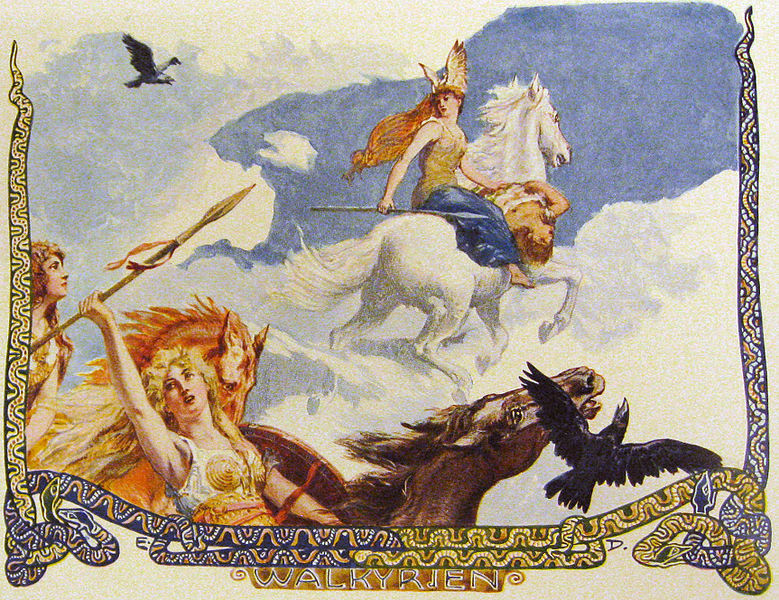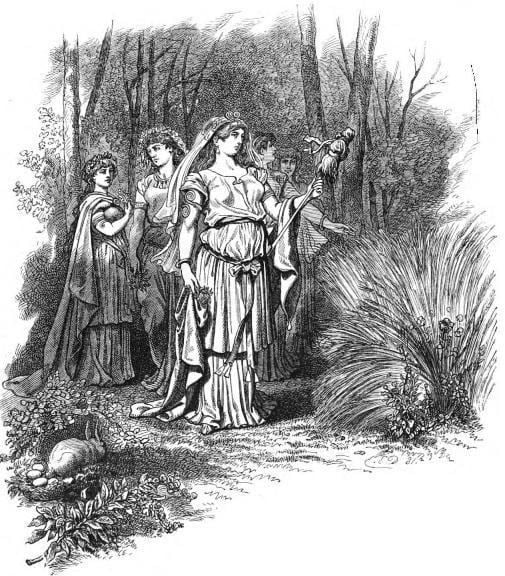
Emil Doepler's Die Götterwelt der Germanen Illustrations
Later on, in the 1870s, costume designer Carl Emil Doepler created horned helmets for the Viking characters of Richard Wagner's "Der Ring des Nibelungen" opera cycle. Alternatively, some experts believe that 19th-century artists could have been inspired by discoveries of ancient horned helmets later determined to predate the Vikings.

Emil Carl Doepler 'The Elder' Illustrations Illustration, Norse mythology, Norse
Costume designer Carl Emil Doepler, who included horned helmets in his gorgeous costume designs for the 1876 performance of Wagner's classic Norse saga, Der Ring des Nibelungen. The gorgeous.

Carl Emil Doepler “Die Nornen”, 1876 The norns, Norse mythology, Mythology costumes
The Norns and the World-Ash. Image credit: Carl Emil Doepler, Jr. (1905) - Public Domain . According to Prose Edda, the spring is one of the three significant springs at the primary roots of the cosmic tree Yggdrasil. Ancient fairy tales in Norse mythology say that this fantastic sacred ash tree had three roots, which sucked water from three different sources.

"ODIN" Carl Emil Doepler Artwork on USEUM
Two names worth mentioning here are Michael Echter and Carl Emil Doepler, both German painters working in close contact with Wagner. Michael Echter was commissioned by King Ludwig II to decorate his palace with murals inspired by The Ring, of which the king had grown very fond.

Carl Emil Doepler (german, 18241905) by PKFNF Forest landscape, Forest art
Carl Emil Doepler was a German artist who was born in 1824. Carl Emil Doepler's work has been offered at auction multiple times, with realized prices ranging from 251 USD to 1,950 USD, depending on the size and medium of the artwork.

Carl Emil Doepler, Junger Manne, 1876 Hans Richter, Richard Wagner, Samurai Gear, Zelda
Carl Emil Doepler (1824-1905) was a German painter, illustrator and costume designer. [1] He created the costumes for Richard Wagner 's opera Der Ring des Nibelungen at the Bayreuther Festspiele in 1876. [1]

Carl Emil Doepler “Rheintochter”, 1876 Opera posters, Creative artists, Artist
One originating source for the horned helmets has been pegged: they were used by Carl Emil Doepler, the costume designer for the premiere of Wagner's opera Ring of the Nibelung at the Bayreuth.

Carl Emil Doepler “Helmwige” , 1876 North Mythology, Mythology Art, Greek Mythology, Richard
When Wagner staged his "Der Ring des Nibelungen" opera cycle in the 1870s, costume designer Carl Emil Doepler created horned helmets for the Viking characters, and an enduring stereotype was born.

Carl Emil Doepler Odin with the wolves Geri and Freki Rob Scholte Museum
In 1876, costume designer Carl Emil Doepler sketched out designs for a performance of Richard Wagner's Der Ring des Nibelungen. Doepler gave Vikings' helmets horns and the rest is history. But why? Carl Emil Doepler/Pinterest Carl Emil Doepler gave the Vikings horned helmets, triggering a myth that lasts to this day.

Carl Emil Doepler 1876 costume designs for the first Ring Cycle Flickr
The image of Vikings with horned helmets first gained popularity in 1876, when costume designer Carl Emil Doepler included them in the costumes for Wagner's opera "Der Ring des Nibelungen." In.

Carl Emil Doepler Alchetron, The Free Social Encyclopedia
Carl Emil Doepler 'The Elder' from Nordisch-Germanische Götter und Helden re-published in 1887 as Unzre Vorzeit by Wilhelm Wagner and Jakob Nover Illustrations varied between the two editions. The following illustrations were published in the first and/or second edition.

Carl Emil Doepler “Waltraute”, 1876 Character design, Valkyrie costume, Comic artist
Carl Emil Doepler 'The Younger' Illustrations from Walhall: Die Götterwelt der Germanen by Wilhelm Ranisch [POPULAR RETELLINGS] Additional Images Available at Boedicca's Bard Heimdall and the Heavenly Bridge : Ing or Scef : Odin and Frigg at Heaven's Window Frigg, Fulla and Gna : Freyja in her Car drawn by Cats.

https//flic.kr/p/2iNqKrM doepler, carl emil Courting Couple in a Forest Landscape 1 Carl
Emil Doepler (29 October 1855, in Munich - 21 December 1922, in Berlin) was a German illustrator, graphic artist, and heraldist. He is usually referred to as The Younger, to distinguish him from his father. Life and work He was born to Carl Emil Doepler, an illustrator and designer, who was head of the costume department at the Bayreuth Festival.

Carl Emil Doepler “Mime”, 1876 Nordic art, Costume design sketch, Germanic tribes
By the 1870s, horned Viking headgear was an integral part of the popular "Der Ring des Nibelungen" opera, thanks to Carl Emil Doepler's costume design [source: History]. These artists and designers didn't just make up the idea of horns on helmets, though. Many helmets predating the Vikings by at least a century were adorned with antlers, wings.

Bid Now Carl Emil Doepler (1824 1905), Romantic Scene Pair of Paintings November 4, 0120
The helmet, popularized by Carl Emil Doepler's original Ring Cycle costume designs, was part of a cultural mania, ongoing for a century at least, among Europeans to invent culture through art.

Carl Emil Doepler Fronleichnamsprozession Stock Photo Alamy
When Wagner staged his "Der Ring des Nibelungen" opera cycle in the 1870s, costume designer Carl Emil Doepler created horned helmets for the Viking characters, and an enduring stereotype was born.